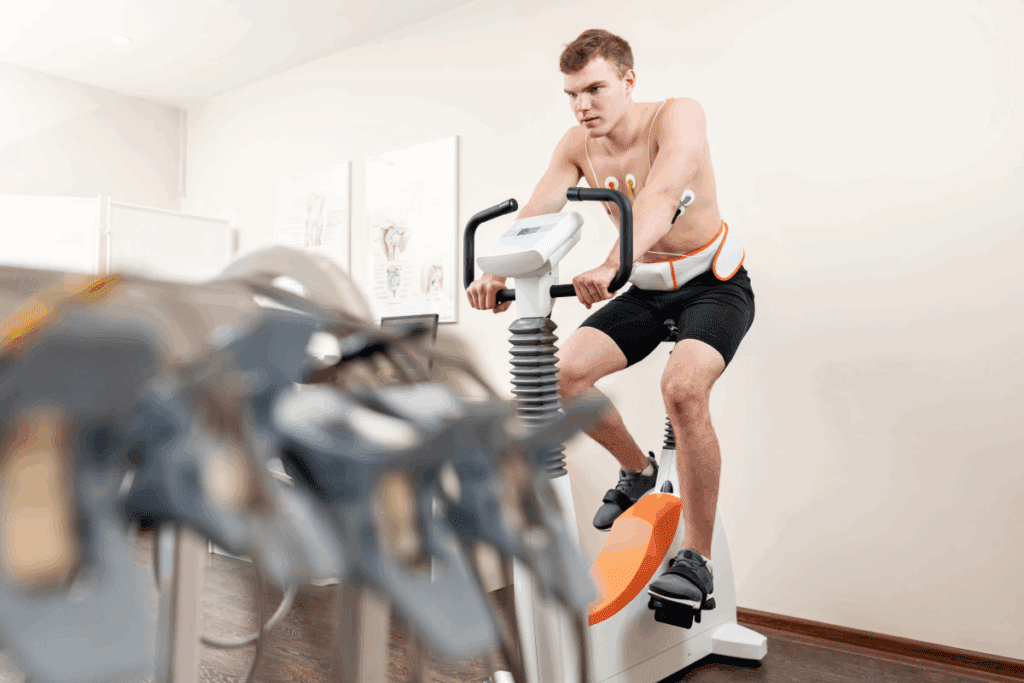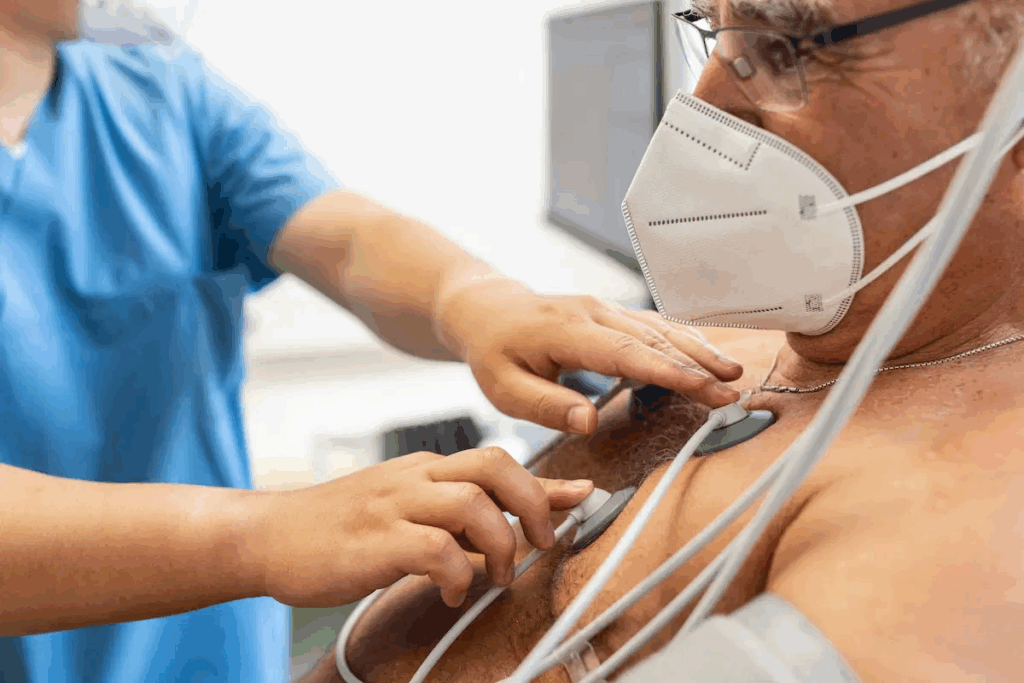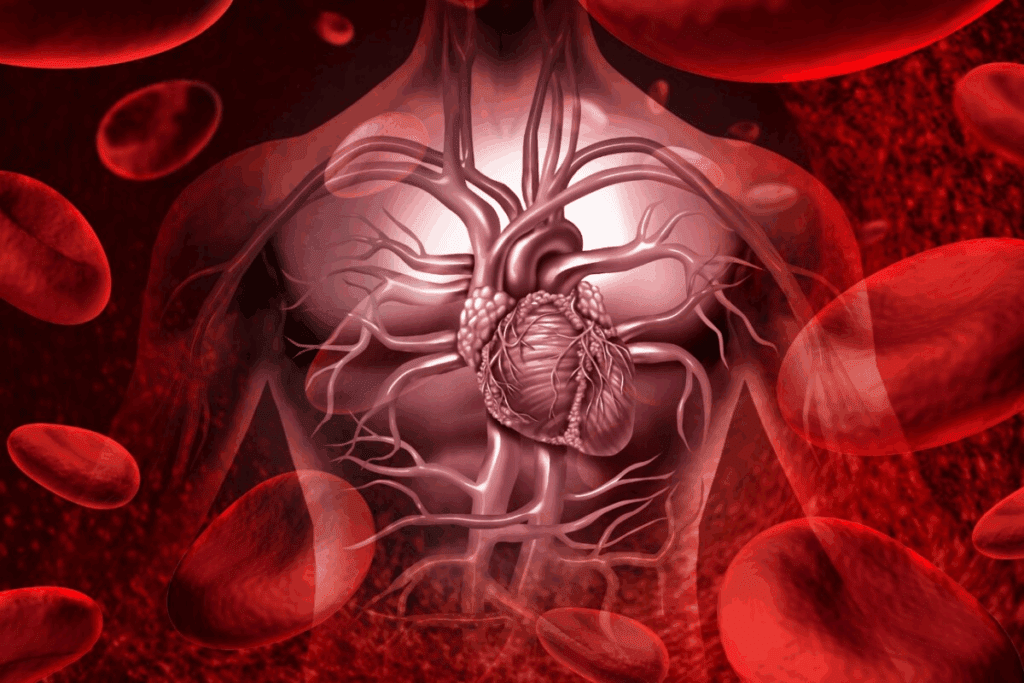Last Updated on November 25, 2025 by Ugurkan Demir

At Liv Hospital, we know how vital accurate heart checks are. Cardiac stress tests are key for spotting heart issues and finding the right treatment.
There are many cardiac stress test options out there, each with its own perks. The main five are the exercise stress test, stress echocardiogram, nuclear stress test, pharmacologic stress test, and cardiopulmonary exercise test (CPET). Knowing about these tests helps patients get ready and understand their results better.

Heart disease is a big health issue. Cardiac stress tests are key in diagnosing it. These tests check how the heart works under stress, like during exercise or with medicine. They help find heart problems and guide treatment.
Cardiac stress tests check the heart’s performance when it’s under stress. We watch the heart’s activity during the test. This stress is usually from exercise or medicine that mimics it. The main goal is to see how well the heart handles stress and spot any problems.
A nuclear stress test is an imaging test that shows blood flow to the heart at rest and during exercise. It helps find coronary artery disease and heart attack risks. The test uses a small radioactive tracer to see the heart’s blood flow.
Doctors suggest stress tests for important reasons. They help find coronary artery disease, where arteries get narrowed or blocked. These tests check if the heart muscle gets enough blood.
Some main reasons doctors suggest stress tests are:
Understanding stress test results helps us make treatment plans for heart health. These plans can include lifestyle changes, medicine, or more medical procedures. The insights from these tests are key in caring for patients with heart conditions.

Heart disease is a big health problem worldwide, affecting millions every year. It’s important to know how big the problem is and what tools we have to fight it.
Heart disease is a top cause of death globally. It takes over 17.9 million lives each year, which is 32% of all deaths. This shows we really need good ways to diagnose and treat it.
Heart disease is common in many places, but some risk factors make it worse. These include high blood pressure, high cholesterol, smoking, diabetes, and not being active. Knowing these risks helps us prevent and catch heart disease early.
Finding heart disease early is key to treating it well. Early detection can help manage many heart diseases, leading to better health and fewer deaths. Cardiac stress tests are a big help in finding problems early.
Using stress tests with imaging makes finding heart problems better. Studies show this combo helps spot coronary artery disease and other heart issues. This means doctors can give better treatment plans.
We need many ways to diagnose heart disease, like different stress tests. Each test is good for different situations, and the right one depends on the patient’s needs.
Key Takeaways:
Cardiac stress tests are advanced tools that show how the heart works under stress. They are key in finding and managing heart disease, a big killer worldwide.
These tests check how the heart reacts to stress, like exercise or medicine. This info is vital for making treatment plans and helping patients get better.
Stress tests measure the heart’s work when it’s under the most stress. This is usually done through exercise, like walking on a treadmill. For those who can’t exercise, medicine is used to mimic the heart’s response.
Key aspects of heart function measured during stress include:
Several important metrics are watched during cardiac stress tests. These help check heart health. They include:
By looking at these metrics, doctors can find out if there’s heart disease and how serious it is. This helps guide further tests and treatments. Knowing how stress tests work and the different types of stress test for heart conditions is key for both patients and doctors.
There are many stress test types, each used for different reasons and benefits. The right test depends on the patient’s health, how mobile they are, and what they need to diagnose.
Cardiac stress tests are key in cardiology. They help doctors see how the heart works under stress. These tests are important because they can find heart problems early.
Cardiac stress tests are mainly used to find coronary artery disease (CAD). CAD happens when the heart’s arteries get blocked. These tests show if blood flow is low, which means there might be a blockage.
Finding CAD early is key to avoiding heart attacks. Tests like nuclear stress tests give clear pictures of the heart’s blood flow. This helps doctors know how bad the disease is and what treatment to use.
Cardiac stress tests also help find heart rhythm problems, or arrhythmias. These happen when the heart is stressed. Doctors watch the heart’s electrical activity to spot irregular rhythms.
These rhythm problems can mean there’s something wrong with the heart. Finding them early lets doctors treat them right away.
Cardiac stress tests also check how well a person can exercise. They see how the heart does during activity. This tells doctors how fit a person is and if there are any limits.
This info is great for making exercise plans that fit a person. It also helps check if treatments are working. It’s also useful for knowing if someone can handle surgery.
Cardiac stress tests come in many forms. Knowing the differences is key for good diagnosis and treatment. We’ll look at the different types, their uses, and how they meet patient needs.
There are five main types of cardiac stress tests. These include the exercise stress test, stress echocardiogram, nuclear stress test, pharmacologic stress test, and cardiopulmonary exercise test (CPET). Each test offers unique insights into heart function under stress.
The exercise stress test is the most common. It involves walking on a treadmill or riding a stationary bike. The heart rate and rhythm are monitored. The stress echocardiogram uses ultrasound to see the heart’s structure and function during stress.
Choosing the right test depends on several factors. These include the patient’s physical condition, medical history, and symptoms. For example, patients who can’t exercise may get a pharmacologic stress test. This test uses medication to mimic exercise’s effects on the heart.
Nuclear stress tests are great for detailed heart imaging. On the other hand, CPET is for a full heart function check. It’s often used for patients being considered for heart transplantation or advanced heart failure treatments.
Each cardiac stress test has its own strengths. Their effectiveness depends on the patient’s condition and the specific question being asked. For instance, stress echocardiography and nuclear stress testing are both good for finding coronary artery disease. But they give different kinds of information.
Knowing how these tests compare helps doctors choose the best one for each patient. This ensures accurate diagnosis and the best outcomes for patients.
The exercise stress test is key in finding heart problems. It shows how well the heart works when we’re active. This test is safe and helps doctors see how the heart reacts to exercise.
Patients walk on a treadmill or bike during the test. The workout gets harder to make the heart rate and blood pressure go up. This mimics the heart’s response to physical stress.
We watch the heart rate, blood pressure, and EKG readings closely. This helps us see if the heart is working right under stress. It also helps spot any heart problems.
Before starting, we put EKG electrodes on the chest and a blood pressure cuff on the arm. The patient exercises to reach a target heart rate. We keep an eye on their vital signs the whole time.
Some people might feel a bit uncomfortable because of the exercise. But most can handle it. We’re there to make sure they’re safe and comfortable.
The test results can show if there’s heart disease, rhythm problems, or other heart issues. We look at the EKG, blood pressure, and other signs to see how the heart is doing.
| Test Metric | Normal Response | Abnormal Response |
| EKG Readings | No significant changes | Ischemia or arrhythmia |
| Blood Pressure | Gradual increase | Excessive rise or fall |
| Heart Rate | Appropriate increase | Inadequate rise or excessive increase |
Understanding the test results helps us create a treatment plan that fits the patient’s needs.
The stress echocardiogram is a top-notch test that mixes exercise or medicine with ultrasound to show how the heart works under stress. It’s great for those who need a close look at their heart health.
Unlike regular stress tests, a stress echocardiogram uses ultrasound to see the heart’s structure and function live. This lets doctors check heart valves, muscle movement, and spots of ischemia more closely.
Key differences include:
First, patients do either exercise stress (on a treadmill) or pharmacologic stress (with medicine). Then, ultrasound pictures are taken before and right after stress. This shows how the heart works at rest and under stress.
It’s key for patients to follow pre-test instructions well to get accurate results.
| Test Phase | Ultrasound Imaging | Patient Status |
| Pre-Stress | Initial images taken | At rest |
| Post-Stress | Images taken immediately after stress | Under stress (exercise or pharmacologic) |
The stress echocardiogram has many pluses, like showing the heart under stress and spotting heart issues better. But, it might not work well for everyone, and it needs skilled techs to read the images.
“The stress echocardiogram is a valuable diagnostic tool that provides critical information about heart function under stress, aiding in the diagnosis and management of heart disease.”
— Dr. John Smith, Cardiologist
As we keep improving in heart tests, the stress echocardiogram stays a key tool. It gives insights that help doctors make better treatment plans and improve patient care.
We use nuclear stress tests to understand how well the heart works under stress. This test uses a radioactive tracer to see the heart’s blood flow. It does this at rest and during exercise or stress tests.
Radioactive tracers are substances that give off radiation. Special cameras can detect this radiation. When these tracers are in the blood, they build up in the heart muscle based on blood flow.
The most used tracers are Technetium-99m (Tc-99m) and Thallium-201 (Tl-201). Tc-99m is great for SPECT imaging because of its good dosimetry and imaging.
SPECT is a way to make three-dimensional images of the heart. It’s often used with stress tests to check how well the heart is getting blood.
PET stress testing makes high-resolution images of the heart. It’s great for checking how well the heart is working and if it’s getting enough blood.
PET imaging is better than SPECT in many ways. It’s more accurate and can spot heart disease better.
Pharmacologic stress tests are key for people with mobility issues. They use medicine to mimic exercise’s heart effects. This lets doctors check how the heart works under stress.
These tests are great for those who can’t do regular exercise tests. Knowing about different pharmacologic stress tests helps doctors care for patients better.
Adenosine and regadenoson are two main medicines used in these tests. They widen the heart’s blood vessels. This lets doctors see how well the heart gets blood when stressed. Adenosine is given through an IV, and regadenoson is a single shot.
Both tests help find heart disease and predict future heart problems. But, they can cause side effects like flushing, chest pain, or breathing trouble.
| Characteristics | Adenosine Stress Test | Regadenoson Stress Test |
| Administration Method | IV infusion | Single IV injection |
| Primary Use | Myocardial perfusion imaging | Myocardial perfusion imaging |
| Common Side Effects | Flushing, chest pain | Headache, shortness of breath |
Dobutamine stress testing is for those who can’t exercise or can’t take other medicines. It makes the heart work like it does during exercise.
This test is good for people with asthma or COPD. They might not handle other medicines well.
Chemical stress tests are for those who can’t exercise because of health issues. This includes severe arthritis, blood vessel problems, or brain disorders. Also, people with big mobility problems or those recovering from surgery might find these tests helpful.
Doctors need to look at each patient’s health and history. This helps decide the best stress test for them.
CPET measures oxygen use and CO2 production during exercise. It’s key for checking heart and lung health. It shows how well a person can exercise.
CPET tracks oxygen use (VO2) and CO2 production (VCO2) during exercise. It uses a treadmill or bike, with the workout getting harder. This shows how well the body uses oxygen for energy.
The main things CPET looks at are:
CPET is not just for the heart. It’s also used in:
CPET data can be complex. But knowing the advanced metrics is key. For example, a high VO2 peak means good heart fitness. A low anaerobic threshold might show muscle oxygen issues.
Key advanced metrics include:
Understanding these metrics helps doctors see a patient’s health better. This leads to more accurate diagnoses and treatment plans.
Liv Hospital leads in cardiac diagnosis, using a team effort for patient care. We know that diagnosing the heart needs more than just new tech. It also needs a full team of experts from different fields.
At Liv Hospital, cardiologists, radiologists, and more work together. This teamwork ensures our patients get care that fits their needs. Our top-notch facilities have the newest tools for heart checks.
Places like Liv Hospital are more than just hospitals. They’re also centers for new ideas and research. We keep our methods up-to-date with the latest in heart care. This means our patients get the best treatments and tests.
We’re always looking to improve with new imaging and tests. This helps us give our patients care that’s just right for them. By using the latest in heart diagnosis, we help our patients live better lives.
Choosing the right cardiac stress test is key for good patient care. There are many types of cardiac stress tests to pick from. This lets doctors tailor tests to each patient’s needs and health.
Healthcare providers need to know about the different cardiac stress tests types and when to use them. This helps them choose the best test for each patient. It ensures accurate diagnoses and effective treatment plans.
The success of cardiac stress testing depends on picking the right test for each patient. This personalized approach improves patient outcomes. It also helps deliver high-quality care.
At places like Liv Hospital, a team of experts works together. They decide on the best tests, including cardiac stress tests, for each patient. This approach provides complete care for patients.
There are many types of cardiac stress tests. These include exercise stress tests, stress echocardiograms, and nuclear stress tests. There are also pharmacologic stress tests and cardiopulmonary exercise testing (CPET).
Cardiac stress tests help find and track heart problems. They check for coronary artery disease, heart rhythm issues, and how well the heart handles exercise.
These tests measure the heart’s function when it’s stressed. This stress is usually caused by exercise or medicine. They watch heart rate, blood pressure, and EKG readings closely.
An exercise stress test uses physical activity to stress the heart. A pharmacologic stress test uses medicine to mimic exercise for those who can’t exercise.
A nuclear stress test uses a radioactive tracer. It shows the heart’s blood flow to diagnose coronary artery disease.
CPET gives a full picture of a patient’s exercise ability. It measures oxygen use and CO2 production. This helps diagnose more than just heart issues.
To prepare, avoid certain medicines and wear comfy clothes. Be ready to exercise or take medicine to stress your heart.
These tests are mostly safe but can cause chest pain, dizziness, or heart rhythm problems. This is more likely for those with heart issues.
A doctor looks at the test results, your medical history, and symptoms. They use this to diagnose and manage heart conditions.
Yes, there are tests like pharmacologic stress tests for those who can’t exercise. They use medicine to simulate exercise.
Technologies like SPECT and PET improve test accuracy. They give detailed images of the heart’s function and blood flow.
Subscribe to our e-newsletter to stay informed about the latest innovations in the world of health and exclusive offers!